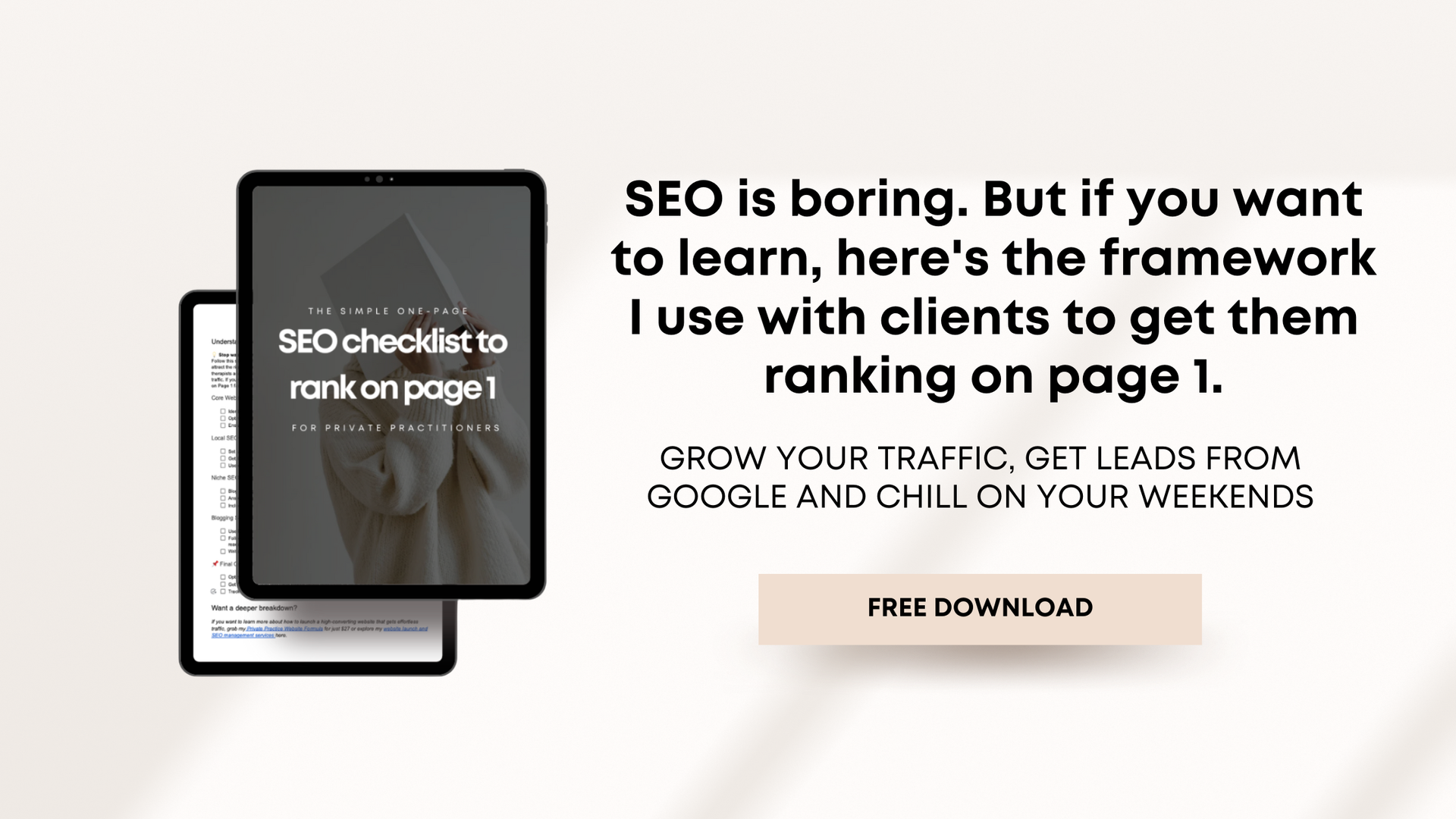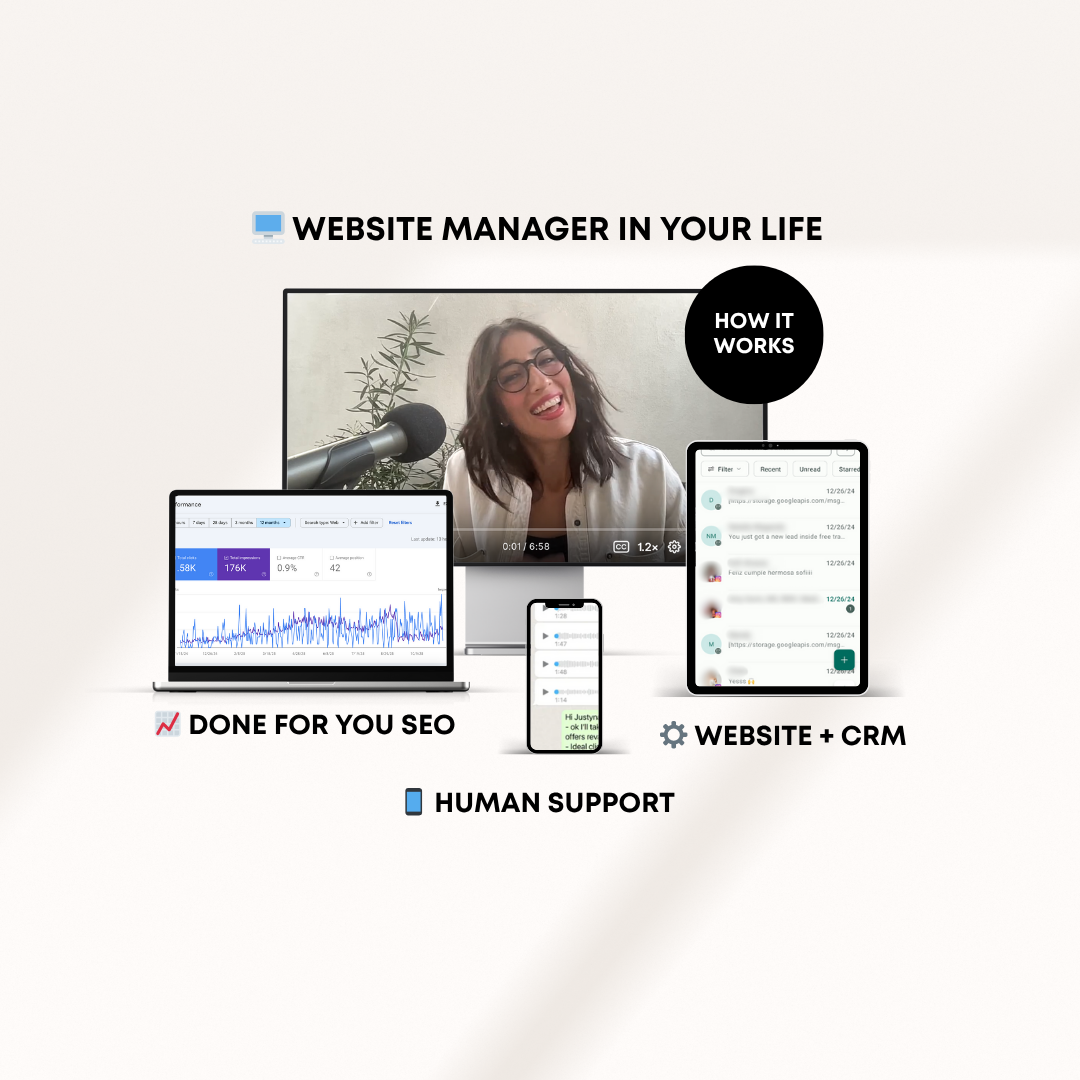SEO for therapists: The guide to getting found online without the burnout
You're not bad at marketing—you're stuck in a broken system
If you've ever felt like SEO is the mysterious secret sauce that everyone seems to be using except you—you’re not alone. Here’s the truth: most private practice owners aren’t bad at marketing. They’re just operating with outdated strategies and too much guesswork.
You didn’t start your practice to become a full-time content creator, strategist, or tech support. You started it to make a real impact. But when the inquiries slow down or the algorithm ghosts you, it’s easy to wonder if your marketing is broken—or worse, if you’re the problem.
You’re not the problem. You’ve just been handed a toolkit without instructions.
This guide is here to change that.
I’m not here to give you another overwhelming “ultimate SEO checklist.” I’m here to simplify. Because when you understand how SEO actually works for your niche, your website stops being a passive brochure and starts becoming your most loyal employee.
Let’s break this all down—clearly, practically, and in language you don’t need a tech degree to understand.
In case you’re new here…
I’m Natalia, and I help private practice owners like you create and manage a strategic, client-attracting website—without the tech headaches. If you want a business that works for you while you focus on your clients, you’re in the right place.
Through my website and SEO management services, I help therapists go from overwhelmed and invisible to confidently showing up with content that connects, converts, and builds a sustainable client base.
What exactly is SEO—and why therapists should care
SEO stands for Search Engine Optimization. It’s the strategy behind getting your website to show up when someone searches for what you do. That might be:
- “trauma therapist in Dallas”
- “EMDR therapy for teens”
- “online therapist for postpartum anxiety”
Google's job is to connect people with solutions. Your job is to show Google that you are the solution.
That’s where SEO comes in. It’s not about tricking search engines. It’s about building a website and content strategy that clearly says: “Here’s who I help. Here’s how I help. And here’s where you can reach me.”
For private practice owners, SEO matters because it allows you to get found by the right clients without constantly pushing on social media, paying for ads, or burning out in the content hamster wheel.

Blogging vs. SEO: What’s the difference?
Blogging is a format. SEO is a strategy.
Here’s how most therapists blog:
- They write about whatever they feel inspired by that day.
- They don’t use specific keywords.
- They post inconsistently.
- They treat it like a diary or reflection journal.
That kind of blogging is helpful for nurturing existing followers—but it won’t bring new people in the door.
SEO blogging is different. It’s intentional. It’s based on:
- Keywords your ideal clients are actually searching
- Content categories that align with your services
- A blog structure optimized for readability and ranking
When you combine thoughtful blogging with strategic SEO, your blog becomes a traffic-generating, client-attracting machine.
Website SEO essentials for private practice owners
Your website should work harder than you do. But for it to do that, you need a few key pieces in place:
1. Fast hosting + mobile optimization
Google favors fast-loading websites. Choose a reliable host (like Duda or SiteGround) and make sure your site is mobile-friendly. If your site takes more than 3 seconds to load, you’re losing traffic.
2. SEO-friendly structure
Make sure you have clean, readable page URLs like
/anxiety-therapy-new-york
instead of
/page123?id=45
. Your navigation should be simple, and each service should have its own page—ideally optimized for a local keyword.
3. Keyword-optimized meta titles and descriptions
Your meta title appears as the headline in search results. Your meta description is the preview underneath it. These should include your core keywords and a reason to click.
Example:
- Title: EMDR Therapy for Teens in Tampa| Trauma-Informed Healing
- Description: Looking for an EMDR therapist for your teen in Tampa? Learn how we help teens process trauma, build emotional resilience, and feel empowered again.
4. Optimized blog strategy
Your blog should support your offers. If you offer trauma therapy, your blog should include posts like:
- “What is trauma-informed care?”
- “How EMDR helps teens after a difficult event”
- “What to expect in your first EMDR session”
Every blog is an opportunity to answer your clients' real questions—and show up in their search results.
SEO terms explained (no tech degree required)
Meta titles
The clickable headline that appears in Google. Should include your target keyword + something clear or emotionally compelling.
Meta descriptions
Short blurbs that tell the reader (and Google) what your page is about. Keep it under 160 characters. Use keywords + one core benefit.
Alt text
Text that describes your images for accessibility and SEO. Every image should have descriptive, relevant alt text.
Backlinks
When another website links to yours. Backlinks are like votes of confidence that boost your site’s authority. Guest posts, features, and directories are all ways to earn backlinks.
SEO settings
These are the backend settings on your website where you manage URLs, meta data, image optimization, and header tags. Tools like Duda and HighLevel (affiliate link) make this easier to manage even if you’re not a tech person.
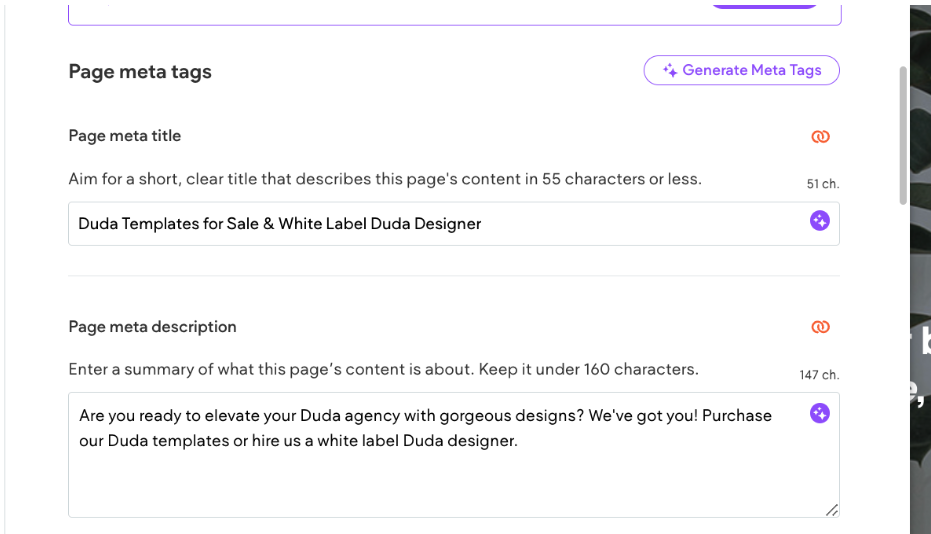
What’s a “good” SEO score?
SEO scores are benchmarks used by tools like Ubersuggest or SEMrush. They’re helpful—but not gospel.
- A score above 70 means your website is generally healthy.
- Above 80 and you’re in great shape.
- But don’t chase perfect scores—chase relevance, structure, and clarity.
The best SEO strategy is one that’s done consistently, not perfectly.
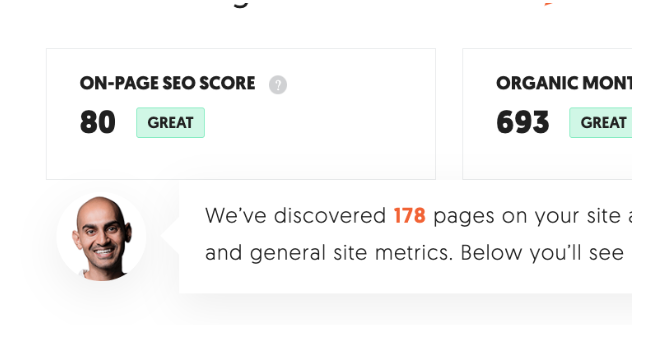
10 simple SEO steps for therapists
When it comes to SEO, the key is consistency. Regularly updating your content, improving your site's speed, and building a network of quality backlinks are all essential ingredients for climbing the SEO mountain. Here are some resources to improve yor seo with this Simple SEO checklist.
1. Plan your quarterly goals
SEO is a long game. What results do you want in 3 months? More inquiries? More traffic? Build a plan to support that.
2. Select 3–5 content categories
Examples: Anxiety, trauma recovery, somatic therapy, private practice growth, postpartum. These categories help Google (and your reader) understand what you’re about.
3. Do keyword research
Use tools like Ubersuggest, AnswerThePublic, or even ChatGPT to find keywords that reflect what your audience is searching.
Tip: Don’t go after the most popular keywords. Choose ones that are specific, like:
- “EMDR for teen trauma”
- “Postpartum anxiety therapy Detroit”
- “Grief therapy for adults near Atlanta”
4. Create a blog post outline before you write
Use H2s and H3s that answer your client’s questions. Keep it readable, skimmable, and focused on 1 topic per post.
5. Batch your blog content
Don’t write one blog at a time. Set aside one week per quarter to write 3–6 blogs in a batch. This reduces decision fatigue and keeps your content consistent.
6. Use AI intentionally
Use AI (like ChatGPT) to brainstorm outlines, write drafts, or generate FAQs—but always edit it with your tone and clinical lens.
7. Follow an SEO checklist for every post
- Keyword in the title
- Keyword in the meta description
- Keyword in the URL
- Alt text on images
- Internal links to related content
- External links to authoritative sources
8. Build internal links
Link to your own blog posts, service pages, and categories. This helps Google crawl your site and keeps readers engaged.
9. Amplify your blog using Pinterest (optional but powerful)
Pinterest is a visual search engine. Create 3–5 pins per blog with headlines like:
- “What is EMDR Therapy?”
- “Postpartum Anxiety: What You Need to Know”
- “10 Signs of Trauma You Might Be Ignoring”
Link the pins back to your blog posts and schedule with Tailwind.
10. Repurpose WITH STRATEGY
Turn your blog into:
- A carousel on Instagram
- A story series
- A newsletter
- A podcast topic
This saves time and reinforces your message across platforms. But with strategy means not copy and pasting the same exact content but shaping your content when relevant to the intent of different marketing channels. EG for Instagram you'll need a curiosity to drive engagement, for newsletters you'll need storytelling to nurture, and not every single blog content should serve a nurture channel, so don't waste your time repurposing SEO content if it's not going to convert social media or newsletter traffic into leads.
Want to learn how to grow your website traffic in the next 12 months?
Learn more about my
website design and traffic growth SEO services for therapists
Remember, SEO doesn't have to be a headache. With the right tools, knowledge, and a sprinkle of creativity, you can boost your online visibility and attract your dream clients effortlessly.
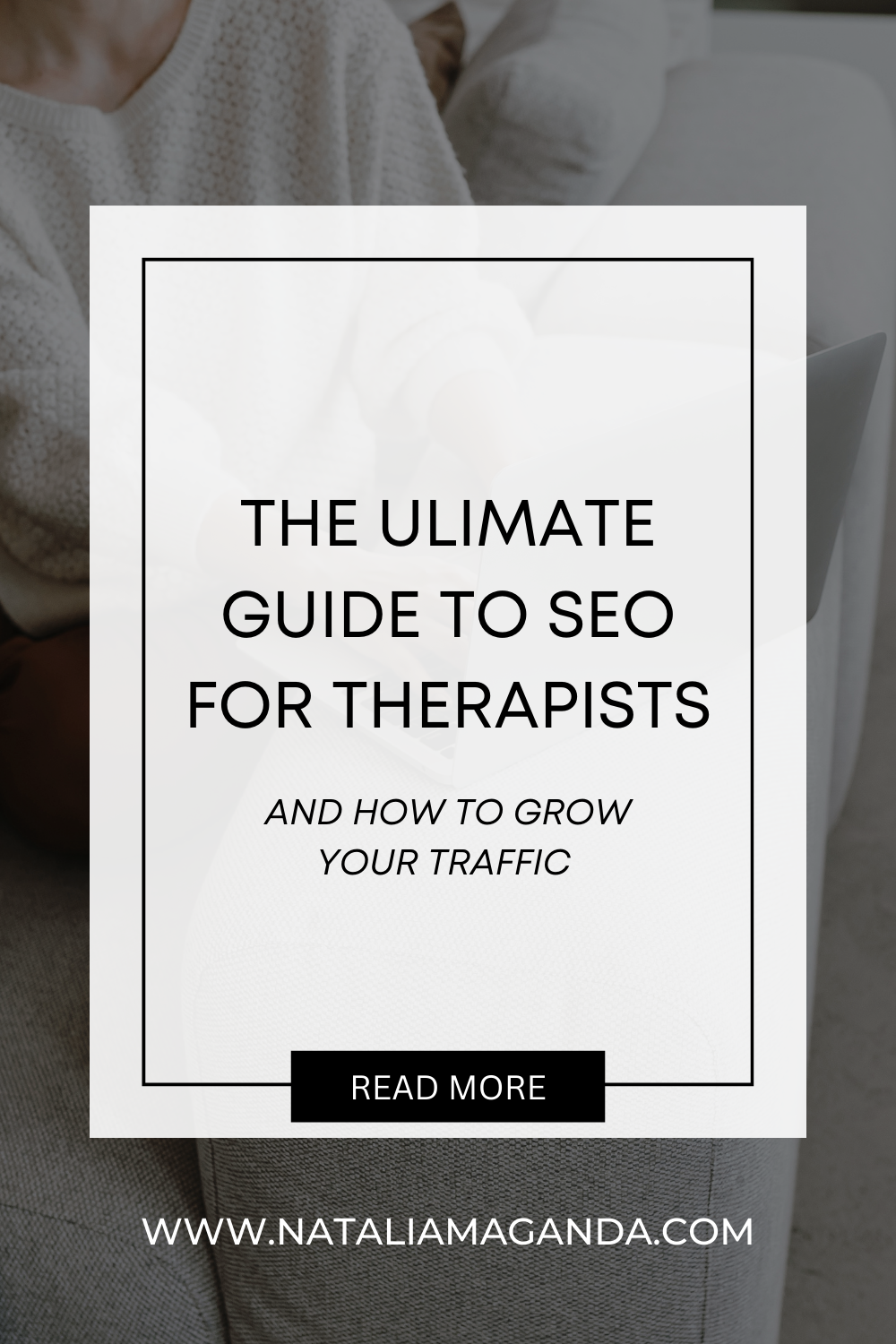
* AI Disclosure: This content may contain sections generated with AI with the purpose of providing you with condensed helpful and relevant content, however all personal opinions are 100% human made as well as the blog post structure, outline and key takeaways.
* Affiliate Disclosure: Some of the links on www.nataliamaganda.com may contain affiliate links meaning that I will get a commission for recommending products at no extra cost to you.

hello! i'm natalia
Latina, web design expert for mental health professionals.
I help ambitious life coaches, therapists and holistic leaders amplify their magic, gain visibility, and simplify their marketing efforts through strategic web design and content.
If you’re looking for an all-in-one system to manage your website, emails, funnels, and CRM, Go HighLevel (affiliate link) is the most powerful tool I’ve tested—and it’s built to grow with you.
On a tighter budget or just starting out? ThriveCart (affiliate link) offers a one-time payment option and easy checkout setups that still pack a punch for digital offers and automation. (Send me an email after your purchase and make sure to use my affiliate link)


